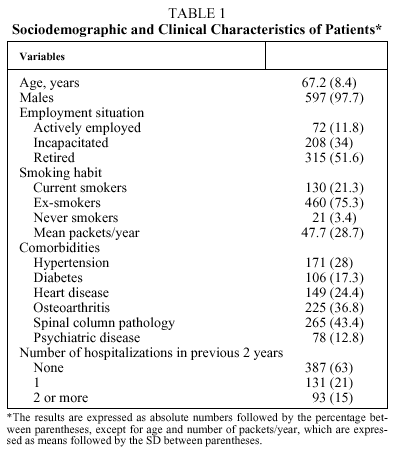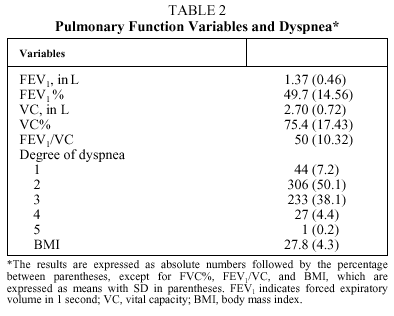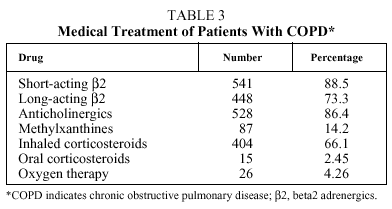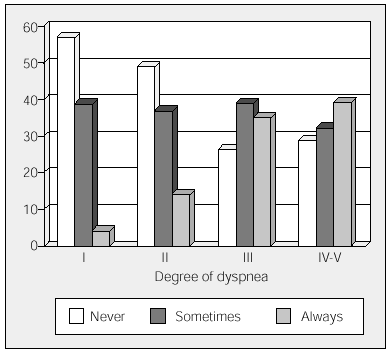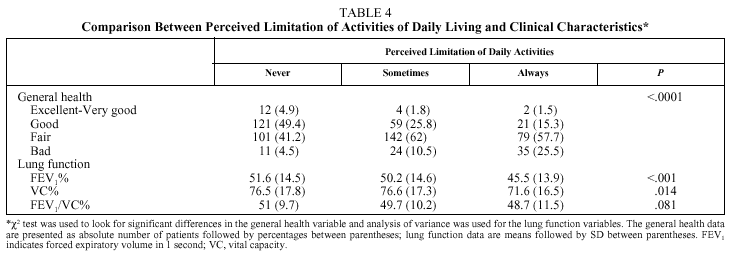Introduction
Chronic obstructive pulmonary disease (COPD) is a very common disease1 with serious socioeconomic and health care implications. COPD and asthma are the respiratory conditions that generate the greatest number of visits by medical specialists.2 The number of visits caused by COPD and related conditions in the United States in 1995 was 16 million.3
Classically, the severity of a patient's illness has been determined by the degree of deterioration in pulmonary function measured by the forced expiratory volume in 1 second (FEV1). Recently, other measurements have been used to provide information on patients' perception of their disease and functional situation. Examples of these measurements are the evaluation of exercise capacity, the degree of limitation in activities of daily living, and the perception of the quality of life related to health. In fact some authors have proposed using a combination of these parameters to categorize COPD.4
The objective of our study was to study the general characteristics of the COPD patients under our care at district respiratory clinics, paying particular attention to the perception these patients have of the degree of limitation their illness causes them.
Methods
Over the period of a year (from February 1998 until February 1999) we studied all patients who had been previously diagnosed with COPD, were under 81 years of age, and came for treatment to one of our 5 outpatient district respiratory clinics. Our hospital serves an area with a population of 300 000 in a region of the interior of Vizcaya, Spain, which includes urban and rural zones.
Patients were consecutively enrolled in the study, had been diagnosed with COPD at least 6 months before, and had been followed at our clinics for at least 6 months prior to enrollment in the study. The clinical situation of the patients had to have been stable (no increase in respiratory symptoms or modifications in treatment) over the 6 weeks prior to enrollment.
Criteria for enrollment of patients were a) FEV1 less than 80% of predicted with a ratio of FEV1 to forced vital capacity less than 70%, and b) negative bronchodilation trial with a FEV1 increase of less than 200 mL and less than 15% with respect to baseline. Patients more than 80 years old, patients diagnosed with asthma, patients who had extensive pulmonary tuberculosis sequelae, neoplastic processes irrespective of location, psychiatric and neurologic illnesses that impeded cooperation, and deafness that made communication difficult were excluded from the study. Patients more than 80 years old were excluded to avoid potential difficulties in completing the study measurements (questionnaires, spirometry). All patients were asked for their oral consent to participate in the study.
All patients had previously received basic information about their disease, using our clinic's protocol, which included general information and advice against smoking and in favor of weight control and regular exercise (mainly, walking every day); nurses had also shown patients how to use inhalation devices.
The evaluation was carried out a single day or, in special cases, within 48 hours.
Patients answered a general questionnaire that covered sociodemographic characteristics, use of medication related to respiratory processes, comorbidities, previous hospitalizations, and general state of health. Patients were asked what they believed had caused their disease and later they were specifically asked about tobacco use as a cause of their COPD.
Patients were also asked to rate their degree of dyspnea on a scale of 1 to 5, adapted from Fletcher et al,5 in which grade 1 corresponded to dyspnea only during strenuous exercise; grade 2: the ability to keep pace with people of the same age walking on level without dyspnea but without climbing hills or stairs; grade 3: the capacity to walk on level without dyspnea but not to keep pace with people of the same age; grade 4: dyspnea while walking slowly for 100 m; and grade 5: dyspnea at rest or during light activities like dressing.
Spirometry was performed following the guidelines of the Spanish Society of Pulmonology and Thoracic Surgery (SEPAR)6 with a MasterScope PC spirometer (Erich Jaeger GmbH & Co, KG, Wuerburg, Germany). Predicted values were obtained from the European Community for Steel and Coal (Comunidad Económica del Carbón y el Acero).7 Severity of COPD was defined according to FEV1 using the stages established by SEPAR.8
General state of health was evaluated with the question, "In general, how would you say your health was?" Answers were given on the following scale: excellent, very good, good, fair, or bad.
Degree of limitation of activities of daily living was measured with the question, "Do you believe your respiratory disease limits your everyday activities?" The scale of answers consisted of "Yes, always;" "Yes, sometimes;" and "No, never."
Statistical Analysis
Quantitative variables were expressed as means (SD), and qualitative variables as absolute numbers and percentages. The χ² test was used to study the relation between perception of limitation to activities of daily living with perception of general health. Analysis of variance was used to study the relation between perception of limitation to activities of daily living and 3 lung function variables. Statistical significance was achieved at P<.05. Data were entered in the program Epi-Info version 6.4 and analyzed using SAS for Windows, version 8.0.
Results
During the study period, 739 COPD patients were identified consecutively; 128 were excluded. Reasons for exclusion were age more than 80 years in 63 cases (49%), neoplasia in 31 (24%), severe hypoacusis in 11 (9%), dementia in 10 (8%), inability to perform spirometry in 4 (3%), and other reasons in 9 cases (7%). Finally, 611 patients were enrolled in the study. Table 1 shows the sociodemographic and clinical characteristics of the patients. The mean age of the patients was 67.2 years and 97.7% were men. Only 11.8% were employed. Only 3 patients (0.5%) lived alone or in nursing homes, and 42 (7%) lived with a single relative or spouse.
Out of the 611 patients, 96.6% had been smokers and 21.3% still were. Mean number of packets/year for smokers was 49.4.
According to SEPAR's COPD classification criteria, 169 patients (27.6%) had mild obstruction, 279 (45.7%) moderate obstruction, and 163 (26.7%) severe obstruction.
The most common comorbidities are shown in Table 1. Pathology of the spinal column (43%) and osteoarthritis (37%) were the most frequent. Cardiopathy was present in 149 patients (24%), 43% of them having ischemic cardiopathy. Regarding the number of hospitalizations related to COPD exacerbations over the previous 2 years, 131 patients (21.4%) had been admitted to hospital once, 93 (15.2%) 2 or more times, and 387 (63.3%) had not been admitted to hospital in the previous 2 years.
The FEV1 of the sample was 1.37 L (mean 49% of predicted). Regarding dyspnea, the majority of the patients reported grade 2 or 3 on the Fletcher scale; the distribution is shown in Table 2.
Medical treatment related to COPD is described in Table 3. The most commonly used drugs were β-adrenergics and anticholinergics, and 66% of patients were treated with inhaled corticosteroids. The most common combination of medications (used by 49% of patients) consisted of β-adrenergics, anticholinergics and inhaled corticosteroids.
When patients were asked what they thought had caused their disease, only 166 (27%) indicated smoking; 113 patients (18.5%) believed it was job related, 91 (15%) attributed it to repeated infections, 48 (8%) to climatic factors, 37 (6%) to a family tendency, and 131 (21%) could not indicate any cause. When asked specifically whether smoking had been a cause of their COPD, 180 patients who were ex-smokers (29.5%) denied this possibility.
Regarding limitations to activities of daily living, 137 patients (22.4%) reported having them "always," 229 (37.5%) "sometimes," and 245 (40.1%) "never." There were no significant differences with respect to age between these groups. Regarding general health, 18 patients (2.9%) qualified their health as "excellent" or "very good," 201 (32.9%) as "good," 322 (52.7%) as "fair," and 70 (11.5%) as "bad".
Figure 1 shows how the degree of perceived limitation varied with the degree of dyspnea. Significant differences were observed in both perception of limitation and degree of dyspnea (P<.001), with limitation perceived as greater when dyspnea was greater. Similarly, differences were statistically significant with regard to general perception of health (Table 4) in function of degrees of dyspnea (P<.001), and when limitation was greater, health was considered worse in all general health categories. For FEV1, only those reporting no limitation were significantly different from all those who reported limitation of any degree; the differences between the 2 degrees of limitation ("sometimes" and "always") were not significant.
Figure 1. Relation between degree of dyspnea, measured according to the scale of Fletcher et al,5 and limitation in activities of daily living. The histogram includes the percentages of patients who presented the various degrees of limitation to activities of daily living within each degree of dyspnea.
Discussion
In this descriptive study of outpatient COPD patients treated at 5 respiratory clinics at primary care centers, supervised by the respiratory medicine service of the Hospital de Galdakao, we found that the degree of limitation to daily activities perceived by the patients was closely related to the degree of dyspnea and the perceived state of general health. Almost all patients were men, and lived with their families; only three lived alone or in a nursing home, in contrast to other countries in Europe where there is a much higher rate of patients who live alone.9 In a health study carried out on people of more than 65 years in the city of Barcelona, 19.9% lived alone, a situation 3-fold more common among women.10 This fact could effect the results of our study, which is almost entirely made up of male patients.
Regarding smokers, 30% of ever smokers in the study denied that smoking had played any part in the development of their disease. This is all the more extraordinary considering that patients were monitored at respiratory clinics that carried out regular programs of patient education and information. In a study to evaluate the utility of an educative program using patients previously diagnosed with COPD and who had not received information, only 48% correctly answered the question on smoking as a causal agent of the disease.11 The educative program was seen to be effective for short-term learning. The authors did not measure long-term acquisition of knowledge, so the information imparted to the patients may be lost over time if not periodically revised. We did not find significant differences in our sample between the percentage of current smokers' and ex-smokers' beliefs about whether smoking was a causal agent of the disease, differences that, had they existed, could have explained the continuation of the smoking habit. Then again, 21% of patients reported being current smokers, a figure probably underestimated according to the data published by Lores et al,12 which found that 34% of smokers with COPD denied continuing to smoke.
Regarding medication patients were taking for COPD, β-adrenergics and anticholinergics were the most common, in accordance with the guidelines for managing the disease.8,13 It should be pointed out that short-acting β-adrenergics are not used regularly but on demand. Inhaled corticosteroids were used by 66% of patients, a finding that seems excessively high but corresponds to reports from other studies. Burge et al, in one such study,14 found that 54% of patients habitually used inhaled corticosteroids, although it is also true that the patients in their sample presented more severe obstruction. These discrepancies are probably attributable to ill-defined indications for this group of drugs; while it has been established that they do not prevent the deterioration of FEV1, they do seem to reduce the number of exacerbations and the loss of health-related quality of life.14 Corticosteroids can also reduce bronchial hyperreactivity and other respiratory symptoms of the disease, such as coughing.15 One observational study has even suggested that inhaled corticosteroids may reduce mortality.16
Regarding comorbidities, 80% of patients enrolled in this study had at least one, data consistent with those previously published by Ferrer et al,17 who saw at least 1 comorbidity in 84% of their patient sample. In both studies, osteoarthritic problems predominated and about 25% suffered heart disease. We found that previously diagnosed ischemic disease constituted 43% of the cardiopathies reported in our study. Psychiatric disease largely consisted of patients diagnosed as suffering from anxiety and depression (81% of the patients with psychiatric conditions). COPD patients are known to have a high prevalence of depression (42% in some studies) and anxiety is frequently present in depressed patients.18 We only reported patients previously diagnosed with these conditions, without further investigating their prevalence in our sample.
Despite the fact that our sample consisted of moderately ill patients, 60% of them reported some limitation in activities of daily living which they attributed to their respiratory disease. The greater the limitation reported, the higher the degree of dyspnea. We used a simplified scale to evaluate limitations to activities of daily living, unlike authors, like Bestall et al,19 who have used more complex scales to demonstrate how the capacity to carry out activities of daily living deteriorates with increases in dyspnea. In Bestall's study, however, patients with mild degrees of dyspnea were excluded. We used the Sickness Impact Profile to show how COPD patients, as opposed to controls, showed significant deterioration in activities of daily living that required physical exertion, especially if an activity involved ambulation, and this had a marked effect on domestic activities and functions as basic as eating and resting. Patients with lower pulmonary function values (FEV1 less than 50%) reported the greatest limitations in activities of daily living.20 Garrod et al,21 while validating a questionnaire on activities of daily living in COPD patents, found a strong correlation with degrees of dyspnea of 3 to 5 on the Medical Research Council scale.19 The patients in Garrod's study came from a rehabilitation program and their mean FEV1 was 0.91 L, explaining why only severe degrees of dyspnea were analyzed.
These same authors used the Saint George's Respiratory Questionnaire to measure the relationship between limitation of activities of daily living and quality of life, and found good correlations for the domains "impact," "activity," and the total score but not with "symptoms," as aspects such as cough and expectoration are included but not dyspnea.
When we evaluated the relation between FEV1 and the degree of limitation reported by patients, we found significant differences between those who reported no limitation and those who did, regardless of the degree. In our sample, patients who reported always having limitations in their activities had a mean FEV1 of 45.5%, in contrast with 51.7% for the group that reported no limitations (P<.001), although FEV1 was not significantly different between the 2 groups characterizing their degrees of limitation differently. Monsó et al22 found correlation between a scale of activities of daily living and FEV1 in chronic COPD patients undergoing long-term oxygen therapy. Other authors, however, have found no correlation between FEV1 and activities of daily living.21
The main limitation to this study was the exclusion, for reasons explained above, of patients more than 80 years of age, who probably have more comorbidities and greater functional deterioration and limitations to activities of daily living. Neither did we include patients whose physical activity was so limited they could not leave home. This explains the scarcity of patients with grade 5 on the dyspnea scale. As the study was carried out in outpatient clinics, we used simplified scales instead of more extensive questionnaires. Despite their obvious limitation, we think the results show the simplified scales to be valid instruments of measurement. On the other hand this is a cross study so patient follow up has not been carried out.
In conclusion, patient's level of knowledge of the causes of the COPD they suffer is inadequate, so patient education about the disease should be periodically revised. Patients seem to be overtreated with inhaled corticosteroids, and a higher level of evidence on the indications of these drugs for COPD is needed. The degree of dyspnea is closely related to a patient's degree of limitation, and perception of state of health is related to degree of limitation. The measurement of dyspnea and limitations to activities of daily living closely reflects the impact COPD has on patients with the disease.
Acknowledgments
Project financed by the Fondo de Investigaciones Sanitarias (no. 97/0326).
We would like to thank M. Cres Alonso, Katalin Belaustegigoitia, Goretti Elustondo, Rosa Díez, and María Prieto for their professionalism and interest.
Correspondence: Dr. C. Esteban.
Servicio de Neumología. Hospital de Galdakao. Barrio Labeaga, s/n. 48960
Galdakao. Vizcaya. España.
E-mail: cristobal_esteban@yahoo.es
Manuscript received December 5, 2002.
Accepted for publication June 7, 2003.


